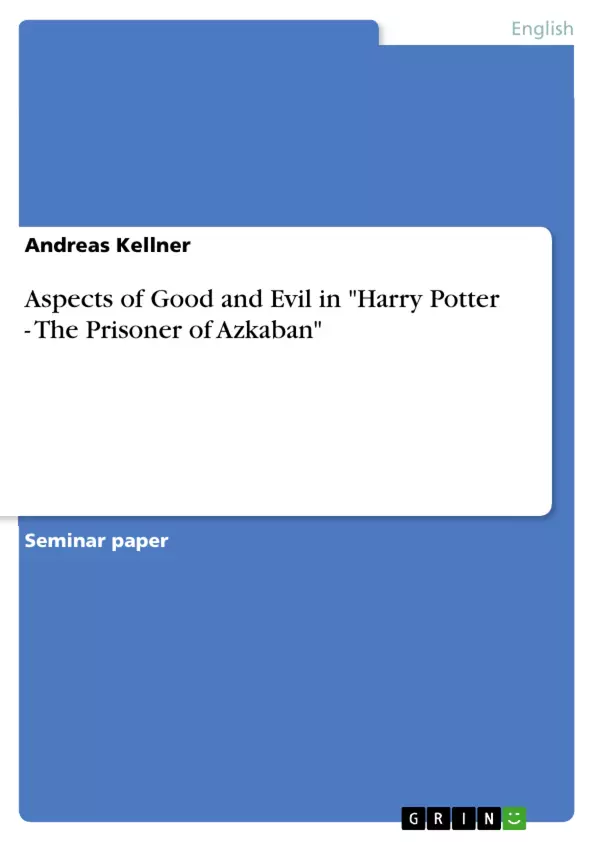In novels and fictional stories we often meet good and evil characters,
characters which fight each other. This fight between good and evil makes the
story really interesting and exciting because it hurries the action along. But often
the reader is not able to say which character really belongs to the good or the evil
ones. It is the ambiguity of the characters and their changes during the story that
grip the readers. This paper will have a look at one exemplary character and try to
solve the question whether it is good or evil. Besides, the thesis that animals and
creatures in The Prisoner of Azkaban cannot be categorized as clearly as the main
characters will be dealt with. In this way different aspects of the terms "good" and
"evil" shall be demonstrated. "Good" and "evil" represent a pair of opposites that is part of many stories and
of our whole life. Actions which are against virtues and values, which are
reprehensible and damnable, are generally seen as evil. Pleasure in destroying, in
lying, in betraying and in being cruel, in neglecting the rights of human beings,
these aspects are declared to be evil.1 They belong to actions and their
consequences which are caused by human beings, for example torturing innocent
people in a war. Due to St. Augustine, these are moral evils or deficiencies of
man's will. He thinks of the moral evil as the true evil because human beings have
free will and the choice to do good or evil. So it is their choice to commit evil
actions or not.2 [...]
1 See Rudolf Eisler, ed. Wörterbuch der philosophischen Begriffe 1, 4th ed. (Berlin: Mittler und
Sohn, 1927), p. 227.
2 See Ester S. Buchholz and Joshua K. Mandel, "Reaching for Virtue, Stumbling on Sin: Concepts
of Good and Evil in a Postmodern Era.", Journal of Religion and Health 39.2, (2000): p. 130.
Table of Contents
- Introduction
- The concept of good and evil
- The eternal struggle of good and evil
- The fusion of good and evil character traits in Sirius Black
- Creatures and animals in The Prisoner of Azkaban
- Good and friendly animals and creatures
- Evil and dangerous animals and creatures
- Are the Harry Potter stories evil in itself?
- Conclusion
Objectives and Key Themes
This paper aims to examine the concepts of good and evil in the context of J.K. Rowling's "Harry Potter and the Prisoner of Azkaban." The analysis will explore the complex nature of characters and their actions, particularly focusing on the ambiguity of good and evil in the character of Sirius Black. Additionally, the paper will delve into the categorization of creatures and animals in the novel, arguing that they cannot be easily categorized as clearly good or evil.
- The concept of good and evil as a fundamental dichotomy in literature and life
- The ambiguity of characters and their capacity for both good and evil deeds
- The portrayal of animals and creatures as moral agents in the Harry Potter universe
- The struggle between good and evil as a central theme in the Harry Potter series
- The ethical implications of magic and its potential for both positive and negative uses
Chapter Summaries
The introduction sets the stage for the paper by highlighting the enduring fascination with the conflict between good and evil in fiction. It points out that the complexity of characters and their capacity for change often makes it challenging for readers to categorize them definitively. The paper will focus on the character of Sirius Black and the ambiguity of his nature, as well as the broader theme of good and evil as it applies to creatures and animals in the novel.
The chapter on the concept of good and evil explores the philosophical and theological foundations of these concepts, drawing upon perspectives from various thinkers like St. Augustine and Socrates. It examines the various interpretations of good and evil, including moral, theological, and natural evil, and contrasts them with the notion of "good" as a positive potentiality.
The chapter on the eternal struggle of good and evil dives into the central conflict of the Harry Potter series, focusing on the battle between Harry and Lord Voldemort as a representation of the larger fight between good and dark magic. It also examines the role of other characters, such as Professor Dumbledore, who act as guardians of good and resist the forces of evil. The chapter then looks at the conflict between Harry and Draco Malfoy, which serves as another example of the ongoing struggle between good and evil within the story.
Keywords
The paper delves into the complexities of good and evil in J.K. Rowling's "Harry Potter and the Prisoner of Azkaban" exploring themes of morality, character ambiguity, animal ethics, magic, and the struggle between light and dark forces. The analysis focuses on the character of Sirius Black, the portrayal of creatures and animals in the story, and the larger conflict between good and evil that permeates the Harry Potter universe.
- Citar trabajo
- Andreas Kellner (Autor), 2002, Aspects of Good and Evil in "Harry Potter - The Prisoner of Azkaban", Múnich, GRIN Verlag, https://www.grin.com/document/23409



